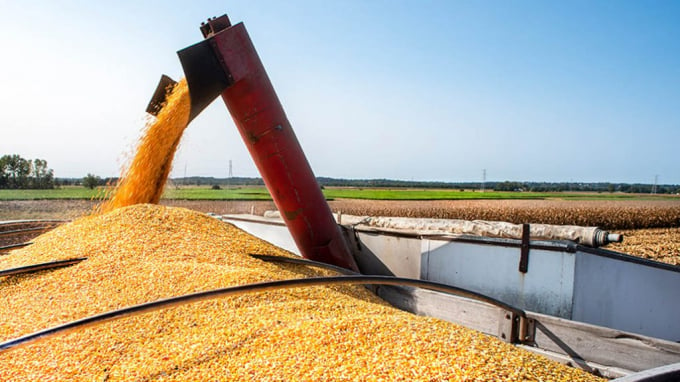November 27, 2025 | 17:37 GMT +7
November 27, 2025 | 17:37 GMT +7
Hotline: 0913.378.918
November 27, 2025 | 17:37 GMT +7
Hotline: 0913.378.918

GM corns are planted in An Giang. Photo: Thanh Son.
Nguyen Than Son, president of the Vietnam Poultry Association (VIPA), said that in recent years, along with the development of the livestock farming industry, the animal feed production sector in Vietnam has also seen a remarkable increase, with an average annual growth rate of 13-15 %.
He stated the figure during a webinar on August 12 co-hosted by the Foreign Agricultural Service (FAS) of the US Embassy in Vietnam, CropLife, and VIP on supplementing the animal feed supply for Vietnam's domestic market.
Until 2020, the overall output of animal feed was approximately 25 million tons, propelling Vietnam into the world's top 10 and Southeast Asia's leading positions in animal feed production.
Tran Ngoc Yen, the head of AgroMonitor, said that when farms and agricultural households combine their animal feed, the overall production countrywide must exceed 30 – 33 million tons.
VIPA predicted that the country's demand for animal feeds will reach 28-30 million tons per year in the next five years. Over half of the production (around 14-14.5 million tons) would be used for poultry farming.
However, the industry is heavily reliant on imported materials, which account for between 70% and 85% of overall material requirements. Exports of commodities for animal feed totaled USD 3.903 billion in the first five months of 2021, up 55% year on year.
Such imported materials for animal feeds have increased on a biannual basis due to the enormous demand for corn, soybean, wheat, and vegetable oil, while domestic agriculture can only supply 4.5-5 million tons of corn, 4 million tons of bran, and 4 million tons of cassava for livestock feed production.

Vietnam is ranked 5th among the world's largest corn importers. Photo: TL.
Due to the high reliance on imported feed ingredients, when the global price of feed materials rises, the production cost and selling price of finished animal feed increase proportionately. Domestic animal feed costs are always higher than the global average as a consequence.
This has been apparent since the end of last year, according to Dinh Thi Thuy Phuong, Director of the Department of Price Statistics (General Statistics Office), who said that feed costs have been from the end of 2020 until now increased eight times. The primary cause is the rapid rise in the global price of feed materials.
In light of the circumstances, many experts believe that the time has come for Vietnam to create a thrifty and rhetorical approach for domestic animal feed development. And one of the most appropriate options is to increase the use of biotechnology to increase the productivity and production of plantation crops used as feed materials to augment local supplies and decrease imports.
Indeed, the majority of goods on the global maize and soybean markets today are genetically engineered (GM). According to Tran Trong Nghia, a spokesman of the American Grains Council, the world's largest suppliers of maize and soybeans are also the world's largest cultivators and producers of genetically modified crops. Currently, GM corn makes for a significant part of the world supply, accounting for about 75% of the total.
According to a recent study titled "The Impact of Genetically Modified (GM) Corn/Maize in Vietnam from 2015 to 2019," GM maize boosted yield by 30.4 percent (equal to 2.03 tons of fresh seeds or 1.27 tons of dry kernels per hectare) when compared to conventional hybrid maize types.
Thus, expanding the planting area of GM maize types increases the possibility for increased seed corn supply in the feed chain. Additionally, GM corn is assisting in increasing family income from VND 3.75 to 6.65 million per hectare.
Additionally, the GM maize demonstrated exceptional resistance to the development of new diseases, with a survival rate of over 90% against fall armyworms. Promotion of science and technology applications and the introduction of novel varieties with high yield and tolerance to climate change are additional strategies for increasing the yield and quality of harvested maize per cultivation unit.
Translated by Linh Linh

(VAN) According to Mr. Vo Minh Thanh, Director of the Tay Ninh Department of Agriculture and Environment, Resolution 57 has created a new development pathway for the locality, shifting from traditional toward modern agriculture.
/2025/11/26/4909-2-154329_878.jpg)
(VAN) Pearl grouper farming in HDPE cages not only delivers economic efficiency but also contributes to protecting the environment, creating jobs, and promoting marine-based experiential tourism.

(VAN) The model of making a living under the forest canopy through the agroforestry system in Van Son commune, Bac Ninh province, is expected to generate an annual income of approximately VND 30 million/ha.

(VAN) Many enterprises in Can Tho are harnessing natural energy and reducing greenhouse gas emissions in their production processes, thereby contributing to the promotion of a sustainable green transition.
/2025/11/24/3536-2-112800_176.jpg)
(VAN) Dong Nai now has tens of thousands of hectares of forests certified for sustainable management, and this area will continue to be expanded in the coming period.

(VAN) Vinh Ha hamlet (Dai Xuyen commune, Hanoi) is shifting away from small-scale farming as households adopt bioscurity into their breeder chicken models.

(VAN) Heavy rains make aquatic species more vulnerable to disease. Proactive water management and high-tech systems help farmers prevent outbreaks and protect yields.